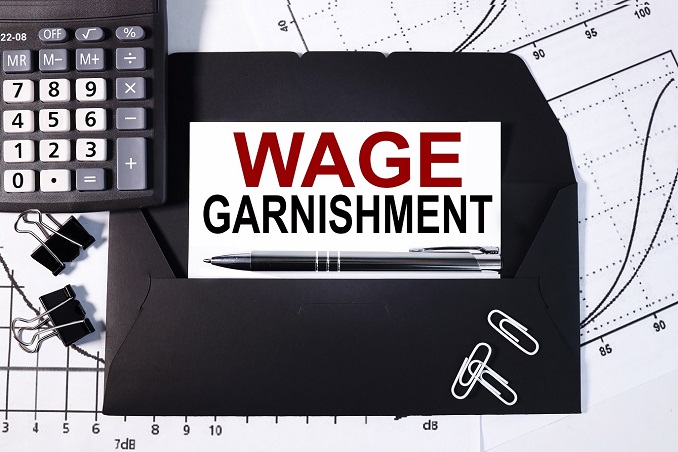Garnishment
What is garnishment?
Garnishment is a way for a creditor to collect a debt by taking the wages, property, or assets of a debtor. The creditor usually must first obtain a final judgment or order against the debtor in court. Once a judgment has been entered, the creditor can collect what is owed.
Process
There are two common types of garnishment proceedings: garnishment of wages and garnishment of property and assets.
After obtaining a judgment, the first step in garnishing someone’s wages is for a judgment creditor to file a Request for Garnishment on Wages. If this is done properly, the court will issue a Writ of Garnishment. The first step in garnishing property and assets is for a judgment creditor to file a Request for Garnishment of Property Other Than Wages. If this is done correctly, the court will issue a Writ of Garnishment.

Wage Garnishment
If the writ is issued for wages, the debtor’s employer (garnishee) will be served with the writ. The writ instructs the employer to withhold wages as directed until the judgment is satisfied, or until the court orders the employer to stop withholding. The garnishee has 30 days to file an answer to the writ.
The creditor is required to send the judgment debtor and the garnishee a monthly judgment creditor’s report. If the creditor does not provide the report, the garnishee or the judgment debtor can file a motion to dismiss the garnishment.
Limitations on Wage Garnishment
- 25% of your disposable earnings for that week, or
- the amount by which your disposable earnings for the week exceed $145.
To the top of the page
Special Laws for Child Support, Student Loans, and Unpaid Taxes
- Child Support
- Maryland follows the federal law (CCPA) on the limits of what can be garnished:
- Up to 50% of disposable earnings may be garnished if you are currently supporting a spouse or a child who isn't the subject of the order.
- Up to 60% of disposable earnings may be taken if you are not supporting another spouse or child.
- An additional 5% may be garnished for support payments over 12 weeks in arrears.
- Federal Student Loans in Default
- the U.S. Department of Education or any entity collecting for this agency can garnish up to 15% of disposable income, but not more than 30 times the minimum wage.
- Unpaid Taxes
- The amount the federal government can garnish depends on how many dependents you have and your deduction rate.
- State and local governments may also be able to garnish your wages to collect unpaid state and local taxes.
Challenges to Wage Garnishment
To the top of the page
Bank Ganishment
Sometimes garnishment is of property and assets, like a bank account. If the Writ is issued for a bank account, after the Writ is served on the bank (garnishee), the bank “freezes” the judgment debtor’s account. This means the judgment debtor will be unable to take money from the account unless the amount in the account is greater than the amount of the garnishment. If additional money is deposited into the bank account, it can be frozen too. The bank has 30 days to file a Confession of Assets with the court. Once 30 days has passed since the original Request for Garnishment (and the garnishee has filed an answer), the creditor can file a Request for Judgment – Garnishment. A copy of this request must be sent to the garnishee and the debtor. If the judgment is entered, the garnishee will turn over the money withheld from the debtor’s account.
To the top of the page
Limitations to Bank Garnishment
- Money in a bank account held jointly by a husband and wife, unless both are judgment debtors or, in some cases, if the account was established after the judgment was entered.
- Federal benefits such as Social Security, federal pensions and disability funds, and child support payments. (You can find a list of the federal benefits that are usually exempt from garnishment on the Federal Trade Commission's website.)
- HOWEVER - Some federal benefits may be garnished to pay delinquent federal taxes or student loans. Others may be able to be garnished for child support or alimony.
- State benefits such as Public Assistance, Workers Compensation, Life Insurance or Annuity Proceeds, and Unemployment Insurance.
- Up to $6000 in cash or property of any kind (you must notify the court within 30 days from the date of attachment or levy by a sheriff).
- Up to $5000 worth of items necessary for the practice of any trade or profession (for example, tools, instruments, books, clothing/uniforms).
- Up to $1000 in household furnishings, goods, clothing, appliances, books, pets and other personal items.
- Money payable to you as the result of court judgments, insurance benefits, child support, and compensation because of sickness, accident, injury or death.
- Professionally prescribed health aids.
- Your share in a retirement plan qualified under federal tax law (to find out if a retirement plan is a “qualified plan” you should contact the retirement plan administrator).
Challenges to Bank Garnishment
- The judgment debtor should use a Motion to Release Property form. Some exemptions have time limits, so this motion should be filed no later than 30 days after the date of the garnishment to get the most protection.
- A person other than the judgment debtor who has an interest in property subject to a garnishment may file a motion as well. This often happens if people share a bank account and one person is a judgment debtor but the other is not.
